Almost a year ago to this day, Fiorentina contested the 2022/23 UEFA Europa Conference League final against West Ham United. A goalless first 60 minutes was followed by two quickfire strikes – a Said Benrahma penalty for the Hammers and a Giacomo Bonaventura strike for the Serie A outfit. As the game looked set to go into extra-time, Jarrod Bowen struck on the counter for West Ham in the very last minute of regulation to steal a 2-1 win for his side, having had fewer shots and lesser possession than their opponents.
On May 29, Fiorentina went through it all again to suffer heartbreak again, this time at the hands of Olympiacos. A dominant campaign that saw them beat Viktoria Plzeň and Club Brugge in the knockouts ended at the hands of the Greeks courtesy of Ayoub El Kaabi’s 116th-minute strike, a near-post header from a cross, to gift the continent its first-ever European trophy. Quite like West Ham, Olympiacos had lesser (albeit marginally) possession and fewer shots and shots on target. However, they disrupted Fiorentina’s in-possession play to a degree that would’ve made most managers proud, while the runners-up missed some glorious opportunities as well.
This tactical analysis report will take a look at some key themes from the UEFA Europa Conference League final, with the analysis discussing the key tactics used by José Luis Mendilibar, brought in only in February, to win his second straight European title after guiding under-performing Sevilla to the UEFA Europa League title last year.
Line-ups
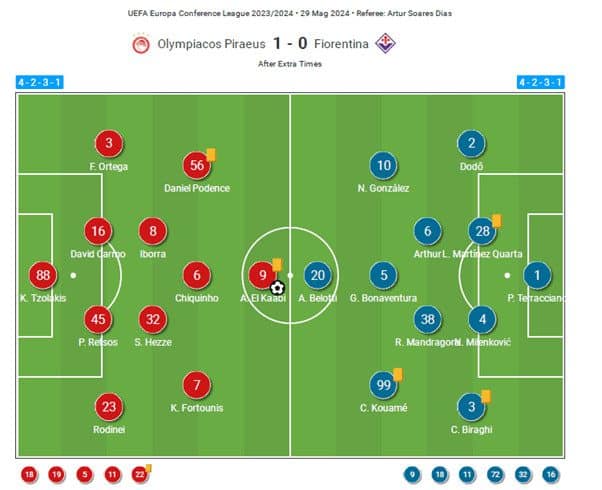
Olympiacos stuck with their familiar 4-2-3-1 formation, one that they’ve used in 88.9% of their Conference League outings this term. They made two changes to the line-up drew 2-2 with Panathinaikos in their final Greek Super League game, with Francisco Ortega replacing Omar Richards at left-back. At the same time, Chiquinho was picked as the ten ahead of João Carvalho. Both Richards and Carvalho dropped to the bench.
Fiorentina countered Olympiacos’ formation with a 4-2-3-1 of their own, a shape Vincenzo Italiano chose in 60% of their Conference League matches. La Viola made four changes to the line-up that helped them edge Cagliari 3-2 in Serie A in their previous match. Centre-back Luca Ranieri dropped out for Lucas Martínez Quarta, while the three men behind striker Andrea Belotti were all switched out. Bonaventura moved up the pitch to replace Antonin Barák as the 10, with Arthur taking the former’s place, while Christian Kouamé and Nicolás González operated on the wings in place of Gaetano Castrovilli and Jonathan Ikoné. Barák, Ranieri and Ikoné all settled for a place on the bench.
Fiorentina force turnovers but fail to take opportunities in 1st half
Fiorentina ended the game with marginally more possession, but interestingly, Olympiacos had the lion’s share of possession early on, recording nearly 62% in the first 15 minutes. However, this did not seem sustainable, largely because they seemed to have come onto the pitch with the aim to go long from goal-kicks, either directly or via the centre-backs. Fiorentina countering their three- or four-man build-up with an equal number of pressers of their own didn’t help either.
In this sequence in the sixth minute of the match, we see a bit of both of this. Olympiacos’ centre-backs fan out, but Fiorentina press the goalkeeper and the left-sided central defender, with pressers ready for the other two defenders in the frame. Goalkeeper Konstantinos Tzolakis can go to either the right-sided centre-back or chip a ball over to the left-back but chooses the most risk-averse option, booting it up-field instead.
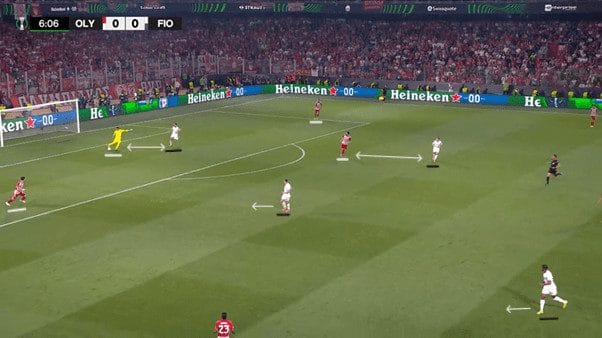
This helped Fiorentina force turnovers in the middle of the pitch, as their defensive territory map below shows. In Kouamé, Gonzalez, and Belotti, the Serie A side also had a front three capable of switching positions, which helped them keep Olympiacos on their toes. That and Kouamé’s pace led to some of their best opportunities in the first half.
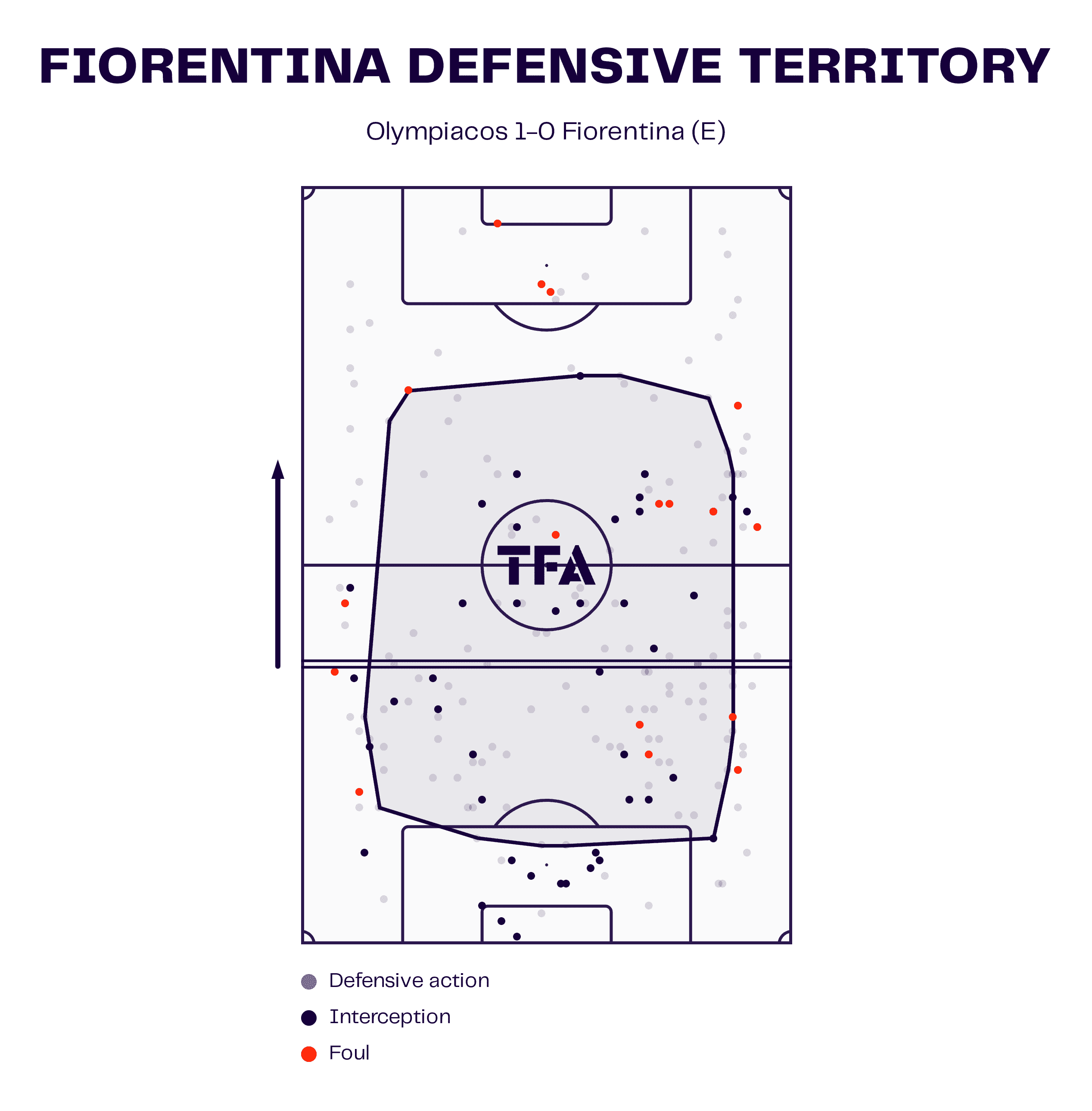
Unfortunately, though, Fiorentina simply didn’t convert their opportunities into goals.
The first of their chances came in just the fifth minute when Kouamé, using his acceleration, helped them break from close to their own box and sent a crossfield ball to Gonzalez, which was a tad too heavy.
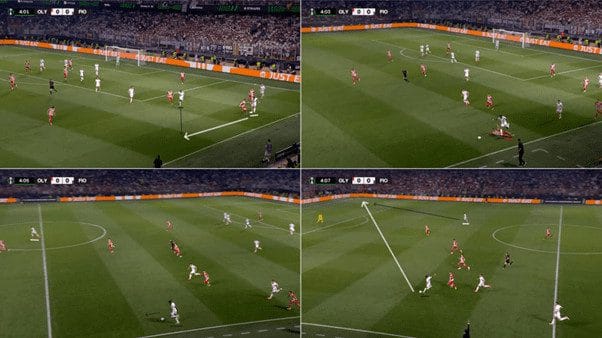
Gonzalez recovered and then beat his man before cutting the ball back, which Kouamé completely miskicked before Belotti fired well wide at the far post.
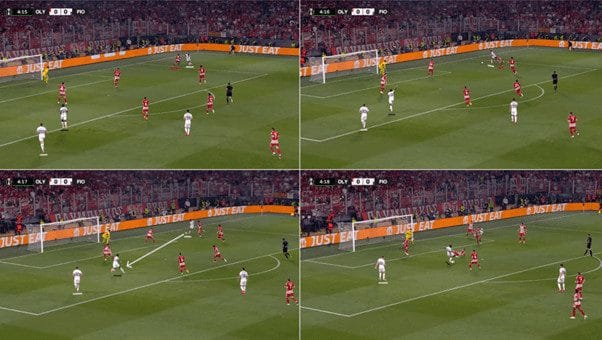
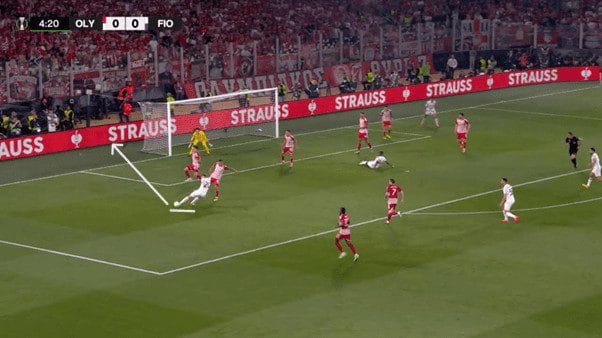
Their second big chance of the game came close to the midway point of the first half, this time via a neatly constructed move that can be broken down into three phases.
In the first phase, we notice Olympiacos’ intense press up the pitch, forcing Fiorentina into long balls (more on that later). However, Kouamé’s smart move to draw right-back Rodinei forward opens up three open spaces (marked numerically) for Fiorentina to attack as the ball bounces to Rolando Mandragora.
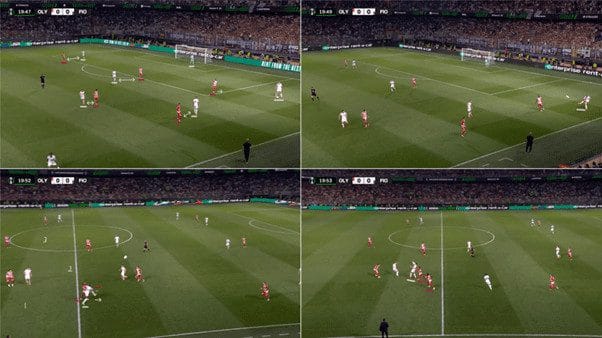
Fiorentina go with space three as Mandragora finds Bonaventura, who in turn spreads it to Dodô and then Rodriguez. From here, Gonzalez crosses for Belotti.
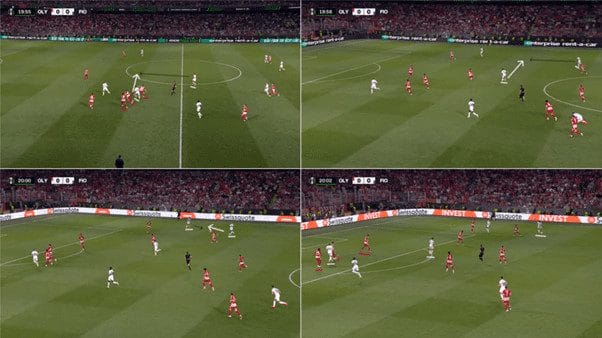
However, it’s cleared before it can reach Belotti. The ball falls for Bonaventura, and the stadium holds its breath in anticipation as he takes a touch to steady himself. Unfortunately, his effort is tame and straight at Tzolakis. In the bottom-right panel, you can see Fiorentina’s disappointment and an equal amount of relief in the Olympiacos players.

Fiorentina’s next clear-cut chance wouldn’t come until a few minutes past the hour mark, leaving one to wonder how the game may have turned out if Bonaventura had finished off this chance. As their shot map below shows, they simply didn’t create enough gilt-edged chances, and when they did, they fluffed their lines.
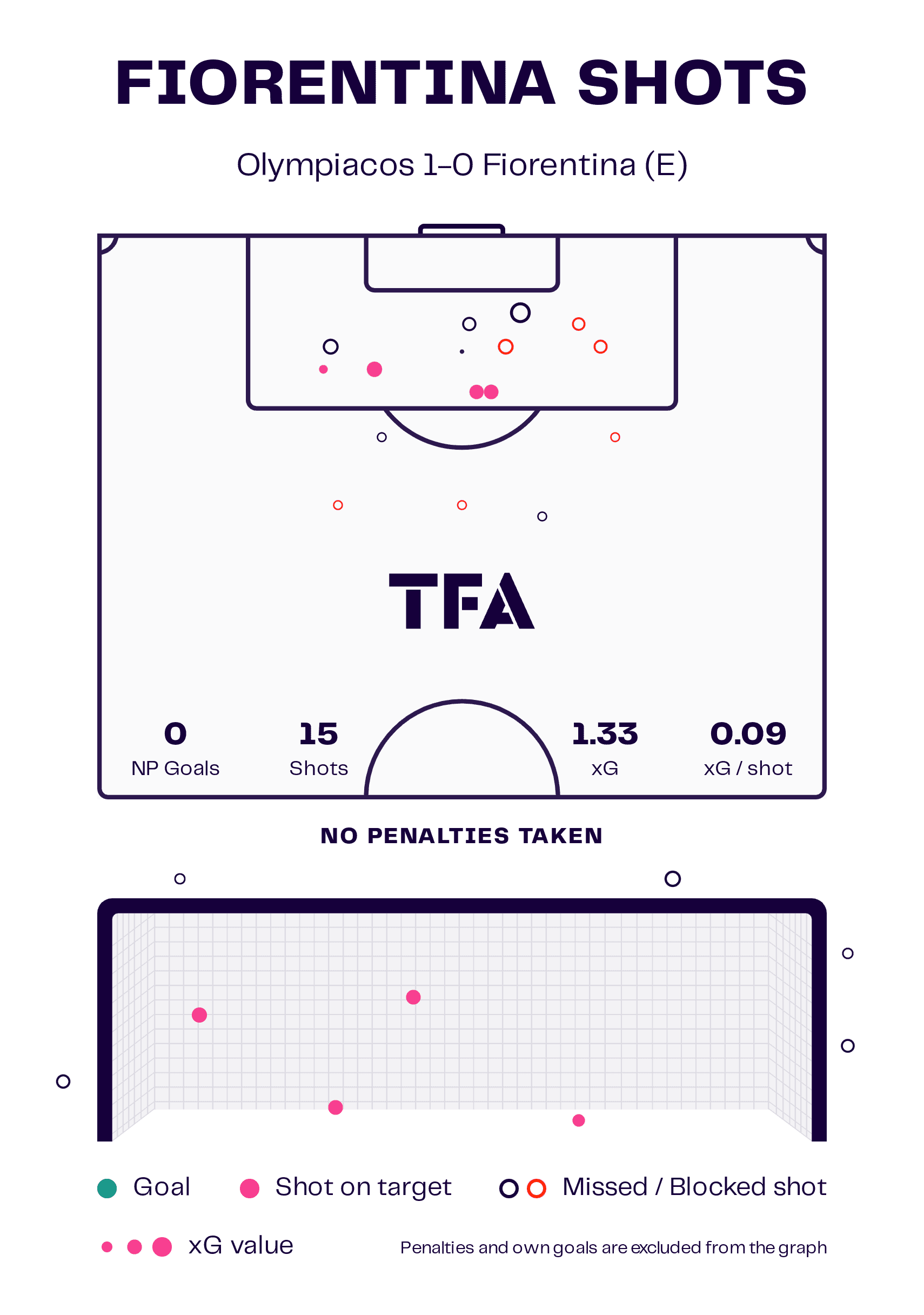
Olympiacos disrupt Fiorentina’s possession play, almost profit from chaos.
In the Conference League final, Fiorentina managed just 51.93% possession, their third-lowest in the competitions this season, only behind the draws against KRC Genk (49.73) and Club Brugge (46.68). They attempted 116 long passes, their highest, and completed only 65.12% of their passes to the final third and 75% of their progressive passes, both of which were the lowest. La Viola’s average pass length was 21.7, the third-highest, and their average passes per possession stood at 3.32, their lowest.
All of these stats illustrate just how difficult Olympiacos made life for them.
As we explained earlier this season, Fiorentina’s build-up play this term has often seen them spread their centre-backs out to the either side of the box with one of the holding midfielders dropping centrally. In some cases, they have also had a third defender stay back and help with build-up. However, as seen in the second sequence above, Olympiacos’ press meant Fiorentina had to go long on most occasions with limited reward.
Their goalkeeper Pietro Terracciano’s pass map from the final, in comparison to his entire Conference League campaign, shows the difference in approach forced on them by Thrylos. Notice the lack of lateral passes and the reliance on booting the ball forward.
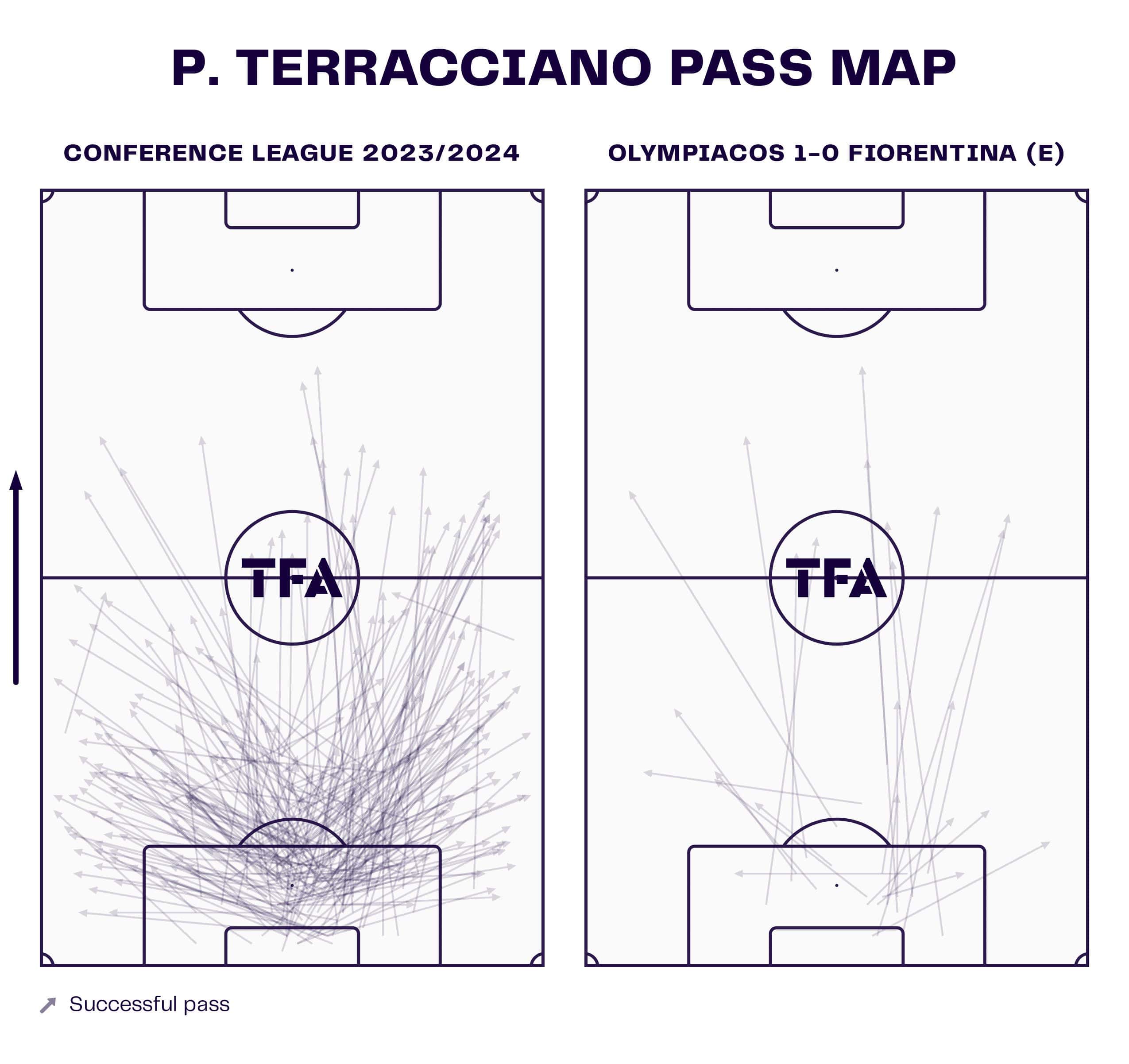
Terracciano notably enjoyed some success in this regard, completing 13 of his 16 long passes and 24 of 27 overall. However, here’s where the second element of Olympiacos’ disruption came into play. In addition to pressing the defence and midfield, Mendilibar, noting the ability of Fiorentina’s front three to interchange, ensured that his four defenders tracked the three forwards and Bonaventura tightly, with license to move out of the defensive line when needed.
In the example below, Terracciano goes long towards Bonaventura, but Carmo gets close to him and wins the header to push it forward to Chiquinho, who in turn feeds Daniel Podence. Podence, a thorn in Fiorentina’s side for much of the first half before a subdued second period, finds El Kaabi inside the box, but he is marshalled out wide by Nikola Milenković, who then clears.
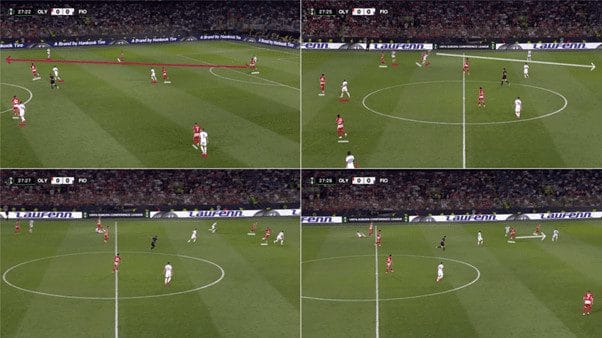
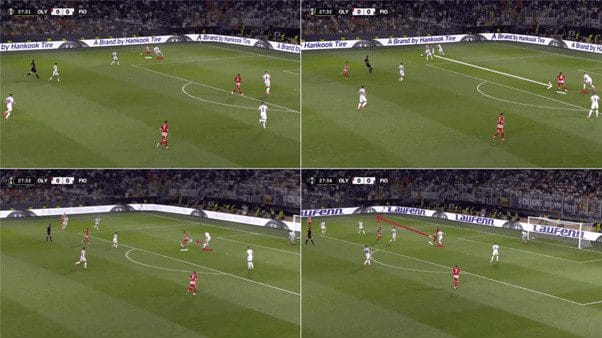
The sequence above showcases how Fiorentina were simply not allowed to send another midfielder back due to a presser being in close proximity throughout, with no triangles in midfield or rhythm passing options. Olympiacos didn’t mind leaving big gaps in midfield, focusing instead on man-marking tightly and daring the Italian outfit to beat them at their own game.
However, as the game wore on and Olympiacos grew tired, Fiorentina found the space to pass through the press. They did so by getting their full-backs to alternate between overlapping and underlapping while their wingers moved appropriately, giving them an extra passing option and keeping their Greek opponents guessing. Italiano’s decision to take off Belotti for M’Bala Nzola also gave them a better chance of physically overpowering Olympiacos’ centre-backs and opening up space if they stepped out.
In the example below from the second half, Terrecciano goes long again, with Panagiotis Retsos coming forward to win the header. This, however, falls to Bonaventura, who wriggles away from two defenders to feed Arthur.
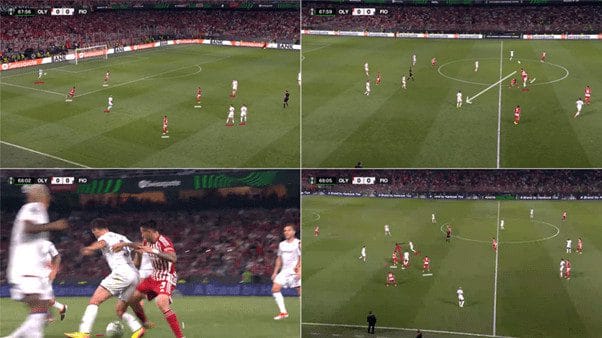
Arthur then plays a long ball to Gonzalez, who swapped wings in the second half and moved to the right in another tactical switch by Italiano, and he gets in front of Carmo, who steps forward.
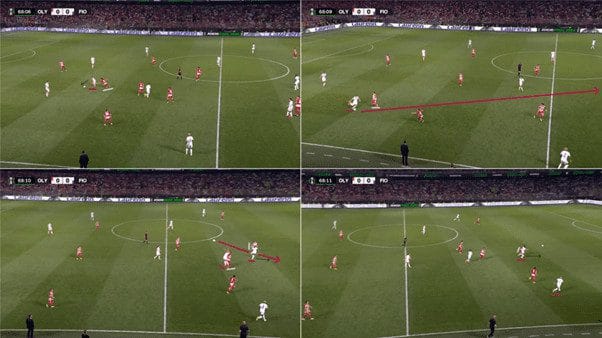
Nzola then outhustles Retsos, giving himself space to run into, and he lays it off for Dodô, who begins the move on the overlap (bottom-right panel above) but makes the underlapping run to receive the ball. The right-back then finds Kouamé, but his tame effort while off-balance is palmed away, albeit unconvincingly, by Tzolakis.

In a nutshell, this sequence summed up Fiorentina in the second half of the final. They could not get their forwards or midfielders involved enough due to Olympiacos’ suffocating man-marking. Italiano’s tweaks with respect to full-back runs and bringing the forwards in closer contact rather than out wide helped them craft an opening, but they failed to take it, quite like the first half.
And when that happens in a final, you usually get punished.
How Ayoub El Kaabi got into the game after a slow start and made the difference
El Kaabi is the latest in the list of orthodox strikers who have become indispensable to teams across Europe this season due to the increase in pressing man-to-man, with the central attacker also providing an outlet to defeat the press.
With Olympiacos seemingly deciding pre-game to go long, El Kaabi was bound to be feeding off scraps. It meant he barely touched the ball in the first half, with Podence on the left and Kostas Fortounis on the right getting themselves into the game more and being involved in moves that led to shots as well. The Moroccan, meanwhile, pressed Fiorentina effectively, but when he got the ball, he was tightly marked by Milenković, who dealt with him as well as possible throughout the match, forcing errant passes or heavy touches.
However, El Kaabi stayed active and almost forced a mistake just before the half-hour mark when he pressed Arthur in midfield. A miscommunication between the midfielder and Dodô almost put him through on goal before they managed to send the ball back to Terracciano. This was followed by the sequence analysed above, where he finally received a pass to his feet in the box but couldn’t control it adequately.
The first sign of El Kaabi’s industry paying off came in the 40th minute when he rose higher than his marker to win a long ball from his goalkeeper. The nod-on was met by Chiquinho, who in turn fed Podence. The Portuguese dinked the ball towards El Kaabi, running off the back of his defender to meet it, but the pass was a tad overhit, and Terracciano rushed out to clear it, clashing with El Kaabi in the process.
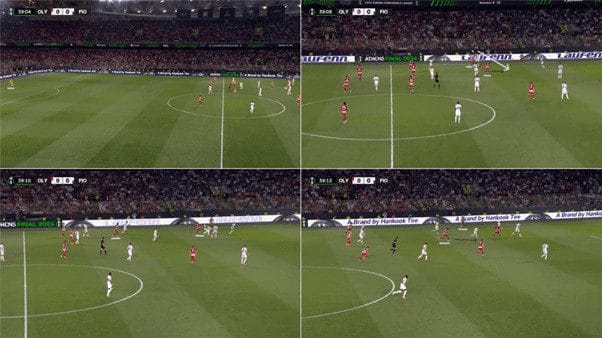
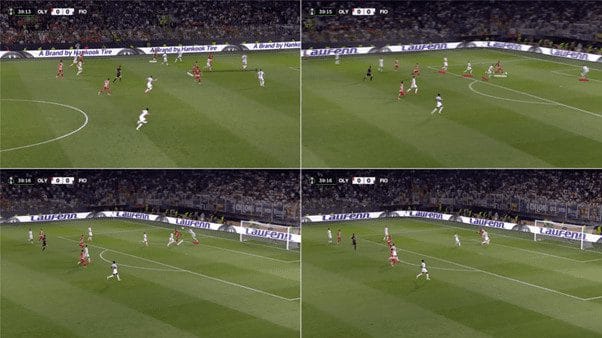
El Kaabi’s initial run forward drags a defender out of position, opening space up for Chiquinho. The forward then has a clear path to run into because Fiorentina’s defenders are scrambling and if the ball is slightly underhit, he would’ve gotten the chance to get a shot away.
Before the end of the half, El Kaabi was involved in two more moves. The first of them saw him make a clever run across the backline to the right to latch onto a long ball from Retsos and lay it off to Fortounis, whose final pass was poor. The second saw one of Olympiacos’ only patient build-ups from the first half as they brought the ball up from midfield, with Chiquinho receiving a line-breaking pass from Iborra with his back to goal. He turned and passed it to El Kaabi, making a run down the right, with the Moroccan switching it back to the left. A couple of passes later, Olympiacos found Ortega racing down the flank, but he was fended off by Dodô.
What was important, though, was that Olympiacos’ star man was slowly getting into the game, one in which they needed him firing on all cylinders.
Within the first 10 minutes of the second half, El Kaabi had already been involved in three key moves. In the 51st minute, he positioned himself well once again to chest down a long ball but lost the ball under pressure. A couple of minutes later, he received a line-breaking pass from Iborra with his back to goal and cushioned it first-time to Chiquinho before getting it back and trying an ambitious switch that was intercepted. In the 56th minute, he collected another long ball, but Milenković stuck to him and saw off the danger.
A quite period followed for El Kaabi as Fiorentina’s tactical adjustments saw them dominate possession before Mendilibar’s decision to bring on Stefan Jovetić brought his striker some relief. With Jovetić asking for the ball more, El Kaabi could conserve a little energy while also linking up with a forward operating closer to him. Deep into stoppage time, El Kaabi met another long ball and nodded it onto the substitute, whose cross was a poor one.
In the second minute of extra-time, the Moroccan, continuing to operate as the chief outlet for Olympiacos, took the ball down with a brilliant touch and fed Podence, who gave it back for him to chase.
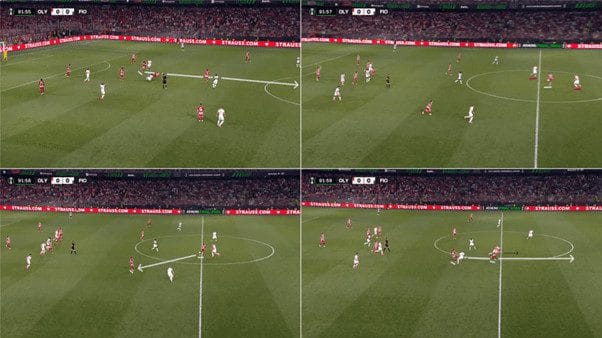
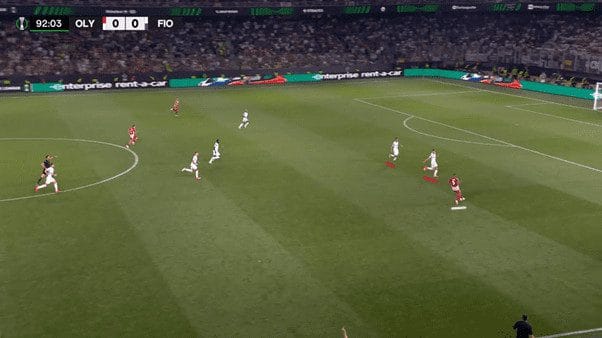
Luckily for Fiorentina, two of their players (including Milenković) stuck to their task and stopped him in his tracks as he looked for options – limited due to Olympiacos defending deep.
A quieter 20 minutes followed before the El Kaabi’s and the match’s defining moment arrived.
In accordance with the trends noticed in previous sections, Olympiacos pressure Fiorentina’s midfielders. Unlike Bonaventura in an earlier example, substitute Barák is unable to both wriggle away and find a pass, doing the former well but overhitting his risky effort to Dodô. The right-back is met by a crunching but fair tackle from substitute Quini, whose clearance finds El Kaabi dropping deep to get himself into space.
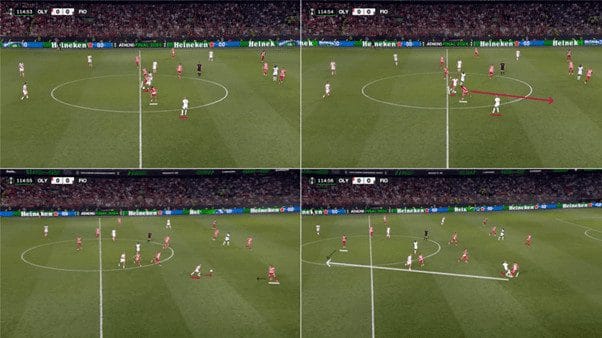
El Kaabi charges forward as Fiorentina scramble to cover the spaces in a 4v3 situation and then spreads it out to André Horta, arguably Olympiacos’ player of the match, after coming on in the 77th minute. Horta’s initial cross fails to reach El Kaabi as it is excellently cleared by Milenković just in front of the Moroccan.
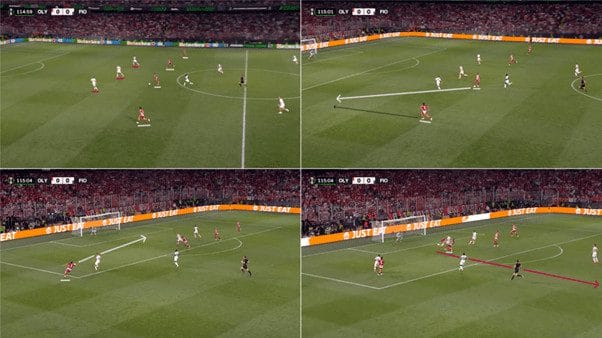
However, Olympiacos won the aerial duel high up the pitch to feed Santiago Hezze. This time, a clever run by Jovetić dragged Milenković to the near post, giving El Kaabi a better match-up. He got ahead of his marker to nod home, sealing a first-ever European title for Olympiacos and Greece.
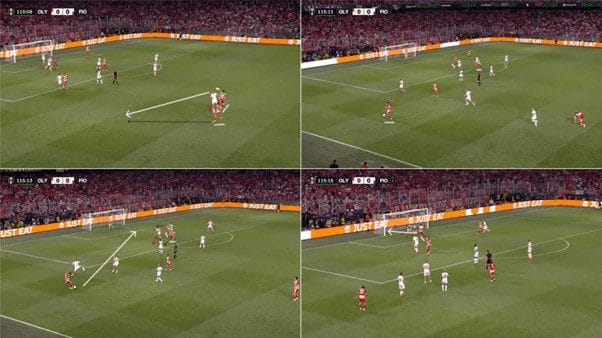
A lengthy VAR check followed before the goal was confirmed. El Kaabi, with his 11th strike of the Conference League season, had won the title for his team. The goal was his only shot on target (out of just two total shots), while his pass in the build-up was only his 10th successful pass from 16 attempts. He also won only nine of his 33 duels, including just five of his 19 aerial duels.
However, those five helped him figure out his positioning, and with a little help from Jovetić, he clinched the Conference League for Olympiacos.
Conclusion
The 2023/24 Conference League final offered up some interesting tactical scenarios for the purist football fan. Fiorentina’s struggles with Olympiacos’ press and their tactical tweaks to remedy the situation was countered by the Greek outfit’s man-marking and disruptive style.
Both teams were largely solid in defence, so the final ultimately came down to the one key aspect we hear about far too often: being clinical. Fiorentina wasted chances early on and failed to create threatening opportunities later on, while El Kaabi scored the one that mattered for Olympiacos with the clock winding down.





Comments